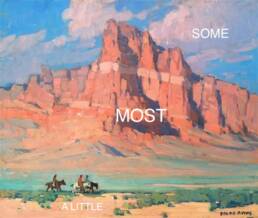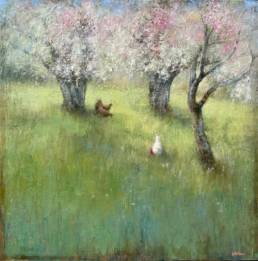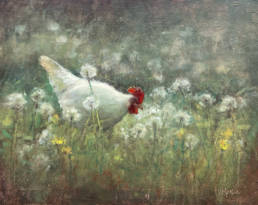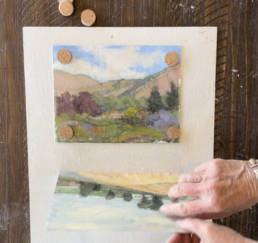
Whether your studio is a posh loft in a fashionable arts district or a spare room in the back of your house, there are times when you need to open it up to show it to others.
To visitors and clients, your studio is more than your creative and working environment; it is a reflection of your business and professionalism.
Most of my work is custom commissioned, and I used to always deliver the finished paintings to my clients rather than have them come to my studio to pick up the art. Then last year I accidentally over booked my commission schedule. Suddenly, I no longer had the time to leave my studio to drive around delivering paintings, so I made it a policy for my clients to come directly to my studio to pick up their art. Not only did I save time, my sales increased dramatically!
Almost every client who visits my studio purchases one or more additional paintings from my inventory. Many bring friends or family with them, who also purchase paintings. The friends and family of the clients feel more comfortable buying art when they are with someone they trust who has just made a purchase. The client’s enthusiasm tends to spill over to their friends, providing everyone with the emotional validation that enables them to make these extra impulse purchases.
Your studio must be clean before a visitor arrives, but there’s more to preparing for a studio visit than just tidying up. Your studio is a reflection of your professional and business standards. If you bring clients into your studio, then it’s more than a workspace, it’s also your reception room. Look at it with a critical eye – what do you think strangers and potential clients see when they see your studio? Are they seeing the workshop and office of a professional? Does it give the impression that you’re organized, punctual, and business like? Does it have an over all atmosphere that is reassuring to the client? If not, it’s time to give it an overhaul!
Setting up the Studio
First off, look at the furniture and how it’s arranged. There needs to be some type seating for your guests, even if it’s just a couple of stools or some folding chairs that you can bring out at a moments notice. A visitor that is sitting down will relax easier than one who is left standing. And it’s equally important for you to sit down as well — if you remain standing while they are sitting they will get the impression that you are in a hurry or that they are imposing on you; as a result, they will feel uncomfortable.
Your studio probably already contains a work table, desk, shelves and cabinets, and easels. But it probably doesn’t need the old coffee table, night stand, lawnmower, or other miscellaneous items that have migrated there from other parts of the house over the years. If you’re not using those items, take them to the thrift store or have a garage sale. Clear up the clutter! If you just can’t seem to part with great granny’s curio cabinet filled with teacups, then at least move it into another part of the house or to the attic.
Now that we’ve cleared some space and gotten rid of some of the bulky items that don’t belong there, let’s look at some of the little things that are cluttering up the room. You’ll still have those shelves and cabinets, so let’s organize how things are put away. You can tidy up those shelves by getting rectangular baskets or bins that fit nicely in the space and will organize and hold your supplies like brushes, paints, tools, photos, etc. Get a file cabinet for your important papers, and there are plenty of ready made options available for filing photos and slides in drawers, cabinets, or boxes. Stacking or wall hung letter trays can provide some organization for those pending entry forms, applications, bills, and other items that are not yet ready to be filed away.
The Walls
Next let’s look at your walls. We all have a tendency to collect art by other artists, but display it in other rooms in your house, not in your studio. Believe me; the last thing you want is for your client to say “WOW! That’s the one I want!”, while he’s pointing to a painting you received at last year’s Christmas exchange at the artists club. Your client came to your studio to view your art, so make sure it’s prominently displayed on your studio walls. You can also display some of your credentials, by framing and hanging some of your best newspaper or magazines articles, exhibit posters featuring your work, and having a space dedicated for hanging ribbons and awards.
You don’t want your walls to be too crowded, so the rest of your inventory needs to be stored in a way that your clients can easily browse through them. This does not mean under the bed or in a closet! Many artists use vertical storage racks, often building them themselves or having them custom built to their specifications. I use a simpler method of arranging framed paintings by size, and leaning them in stacks against the walls that the clients can flip through. Unframed paintings are best displayed in poly bags or shrink wrap, and placed in print racks or bins that the client can flip through.
Prints or posters should be displayed in a separate rack. Be sure to have each piece neatly labeled with title, medium, and price. Buyers are much less likely to question the cost or try to haggle if the prices are cleanly printed and clearly displayed on each piece.
Branding & Marketing Materials
Like any good sales room, you’ll want to have display fixtures to hold your business cards and brochures, and some acrylic stands displaying bio or statement. Keep a full and up to date portfolio or catalog handy in your studio for the clients to browse through, and a binder filled with articles, reviews, and tear sheets is also handy.
The Lighting
Lighting is important. All art looks best under natural light, so use full spectrum bulbs in your light fixtures and lamps. I like to leave one large space open on one of my walls, so I can quickly pick up and hang a painting from my stock for the client to see how it will look at eye level. This particular area could be set up as a comfortable alcove or sitting area.
Sales Tips
Be courteous to your visitors; take your phone off the hook while your clients are there so you won’t be disrupted, and if you have children, pets, or other animate objects like a husband, send them out or stash them away somewhere.
Your clients may have traveled a significant distance before arriving at your studio, so be sure to have an assortment of beverages to offer them and perhaps a tray of nibbles like cheese and crackers or grapes. For the same reason, make sure your bathroom is clean and tidy with fresh towels. Also insure that they can easily find your studio by making sure your address is visible on your building or door, and you have large enough signage that is easily read. Even if your studio is in a residential area, you can usually put out a temporary sign for a few hours that will confirm to your guests that they’ve arrived at the right address.
I use two rooms in my home for my art business, one is a reception room where I store all the finished art and show it to clients, and the other room is my actual painting studio. Before they leave I guide the clients through a tour of my work studio, showing them paintings in progress and explaining the painting process. Clients love this, as it gives them a better appreciation and understanding of art, and it also personalizes the experience for them. It allows the client to establish a bond with the artist, making it easier to close a sale.
The environment in which you work has a direct impact on how you feel. You’ll find that an organized professional studio space not only impresses your visitors, it will also boost your confidence. An inviting and organized studio provides you with the motivation to conduct your business in a more professional manner. As this healthy cycle continues, it will help you feel more energized, refreshed, and creative, and will inspire you to increase your productivity and sales even more.
Guest artist/author: Annie Strack is an Official Authorized Artist for the U.S. Coast Guard, an Artist Ambassador for Canson | Royal Talens, and a Contributing Editor for Professional Artist magazine. A Signature Member of 8 artist societies, her artwork has received hundreds of awards and hangs in over 1,000 collections worldwide including US Coast Guard, US Navy, US Pentagon, US Senate, Veterans Administration, and many more. She teaches painting at Artists’ Network University, and for other organizations in workshops and classes around the country. Her show “Painting Seascapes in Watercolor” is available on DVD and also broadcast on over 130 television stations around the world.
*****
I hope to meet you on Twitter, and on Google Plus, Pinterest, and join in the fun at Fine Art Tips Facebook Fan Page! Please checkout my art too LoriMcNee.com, or find me on Instagram lorimcneeartist.








These are great ideas, underreported I think, that artists will really benefit from. As will I! Thanks for the post.
Hello Jann, great feedback. I hope you can use some of these tips next time you plan an open studio of your own. 🙂